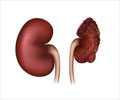Highlights:
- India's breakthrough in developing a mathematical model for tuberculosis burden estimation is a significant step forward in TB control efforts
- The model has several significant implications for tuberculosis control programs, including identifying tuberculosis hotspots, evaluating program performance, and better resource allocation
- The collaboration between the Indian government, WHO, and the Stop TB Partnership has been crucial in developing the model, which can be a valuable tool for TB control programs worldwide
India has set a remarkable achievement in
tuberculosis (TB) control by developing a mathematical model that accurately estimates the country's tuberculosis burden cases. India has been leading the world in tuberculosis cases, accounting for nearly 27% of the global tuberculosis burden. With this breakthrough model, the country aims to strengthen its fight against tuberculosis and improve treatment outcomes for patients.
‘India has developed a groundbreaking mathematical model in collaboration with WHO & Stop TB Partnership, to estimate the country's tuberculosis burden cases, improving treatment and outcomes for patients.’
Advertisement
India's Struggle Against Tuberculosis
Despite a decline in tuberculosis cases in recent years, India is still facing challenges in combating the disease. Tuberculosis remains one of the most significant public health issues in India, with nearly 2.6 million cases and 440,000 deaths reported annually. The
COVID-19 pandemic has further impacted tuberculosis control efforts, leading to disruptions in diagnosis, treatment, and surveillance.
Advertisement
India's Mathematical Model for Tuberculosis Burden Estimation
The innovative mathematical model developed by India is a significant step towards improving tuberculosis control measures in the country. The model estimates tuberculosis burden cases based on several factors, including age, sex, geographic location, and tuberculosis program performance data. The mathematical model also considers various data sources, such as tuberculosis notifications, drug resistance surveys, and mortality data. By using advanced statistical techniques, the model provides more accurate estimates of tuberculosis cases in the country.
Advertisement
Impact of India's Mathematical Model on Tuberculosis Control
India's tuberculosis burden estimation model has several significant implications for tuberculosis control measures. The model helps to identify tuberculosis hotspots in the country, enabling targeted interventions and better allocation of resources. It also helps to evaluate the performance of tuberculosis control programs and assess the impact of new interventions. The accurate estimation of TB cases can also lead to better resource allocation and more effective planning for tuberculosis control measures.
Collaboration with WHO and Stop TB Partnership
India's success in developing the tuberculosis burden estimation model is a result of collaboration between the Indian government, the World Health Organization (WHO), and the Stop TB Partnership. The WHO and the Stop TB Partnership have been actively supporting India's tuberculosis control efforts for several years. The collaboration has been crucial in developing the mathematical model, which is expected to be a valuable tool for tuberculosis control programs worldwide.
Future Implications of India's Mathematical Model
India's mathematical model for tuberculosis burden estimation has far-reaching implications for tuberculosis control efforts globally. The model can be adapted and used in other countries with a high tuberculosis burden. The accurate estimation of tuberculosis cases can also help to monitor progress towards global tuberculosis elimination goals. India's model can be a valuable tool in achieving the targets set out in the United Nations Sustainable Development Goals (SDGs) to end the tuberculosis epidemic by 2030.
Source-Medindia















